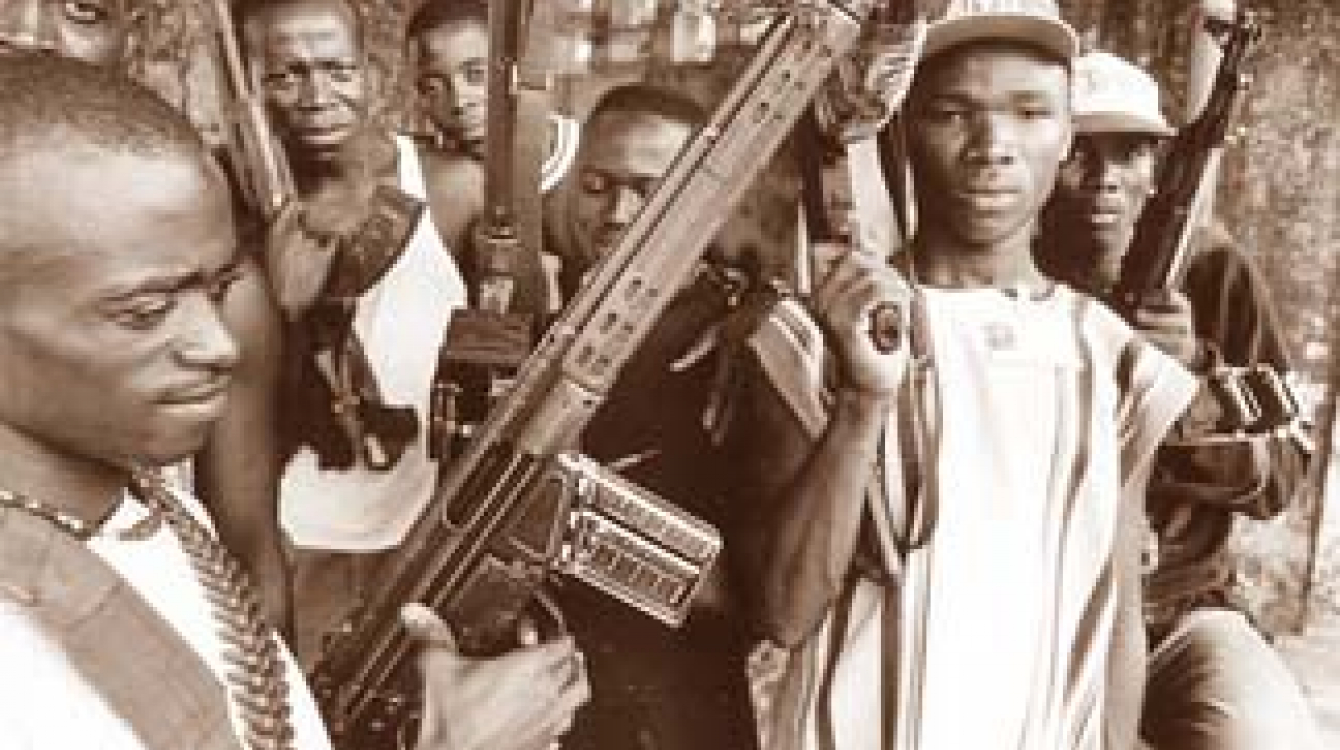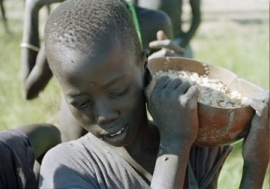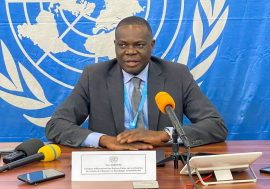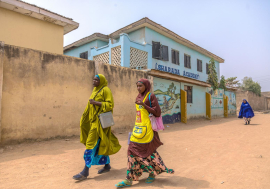Small arms in Africa
The dry rolling plains of northern Kenya seem an unlikely place for an arms race. But in less than a generation the pastoral Pokot people and their neighbours have gone from protecting their herds with spears to outfitting their young men with cheap, reliable and deadly automatic rifles from the war zones of Somalia, Ethiopia and Sudan. The impact of modern military weapons on the Pokot and surrounding communities was brought tragically home in early 2001, when Pokot youth opened fire on a rival settlement, killing 47 people, burning down the village and transforming the almost-ceremonial tradition of cattle raiding into an occasion for human slaughter. "Guns are changing things," one young Pokot man told the Washington Post newspaper. "The young ones, they don't respect elders." "If you don't have a weapon," added another, "your grave is open."
Photo: © Impact Visuals / Teun Voeten
In fact, small arms, which include rifles, pistols and light machine guns, are filling African graves in ever-increasing numbers -- from the killing fields of Burundi and the Democratic Republic of Congo to the streets of Lagos and Johannesburg. While the international community searches, so far unsuccessfully, for agreement on the regulation of the global trade in small arms, a growing number of African countries, UN agencies and non-governmental organizations are grappling with the human and development consequences of gun violence and seeking to reduce both the supply and the demand for what Secretary-General Kofi Annan has called "the weapons of choice for the killers of our time."
Reducing the availability and use of small arms in places where fighting has ended has become increasingly important to Africa's development prospects as the number of conflicts has increased over the past decade. The widespread abuse of weapons diverts scarce government resources from health and education to public security, discourages investment and economic growth, and deprives developing countries of the skills and talents of the victims of small arms.
Millions of light arms -- lightweight, highly portable, and devastatingly effective in the hands of even young or poorly trained users -- were shipped to Africa during the Cold War to equip anti-colonial fighters, newly independent states and superpower proxy forces alike. The collapse of the Soviet bloc saw a new flood of small arms entering Africa as manufacturers put additional millions of surplus Cold War-era weapons on the international arms market at cut-rate prices.
Years later, these durable killing machines fight on in the hands of insurgents, local militias, criminal organizations and ordinary people left vulnerable to violence by ineffective policing and simmering civil conflict. In some parts of Africa, a Soviet-designed AK-47 assault rifle, coveted for its simplicity and firepower, can be purchased for as little as $6, or traded for a chicken or sack of grain. In 1999 the Red Cross estimated that in the Somali capital of Mogadishu alone, the city's 1.3 million residents possessed over a million guns -- among an estimated 550 mn small arms in circulation worldwide.
The widespread abuse of weapons diverts scarce government resources from health and education to public security, discourages investment and economic growth, and deprives developing countries of the skills and talents of the victims of small arms.
"The proliferation of light weapons in Africa poses a major threat to development," noted Ms. Virginia Gamba, the former director of the Arms Management Programme of the South African Institute for Security Studies (ISS). Their low cost, ease of use and availability "may escalate conflicts, undermine peace agreements, intensify [the] violence and impact of crime, impede economic and social development and hinder the development of social stability, democracy and good governance." In July 2001 the US government estimated that small arms are fuelling conflicts in 22 African countries that have taken 7-8 million lives. In Africa guns are not just the weapons of choice but also weapons of mass destruction.
When weapons outlast wars
The development impact of war on individuals, communities and states is unambiguous and well documented. By its nature -- and sometimes by design -- modern warfare destroys economic and social infrastructure, uproots populations, paralyses economic activity, disrupts vital health and education services and diverts financial resources from development to defence.
Less well understood is the impact of small arms on development in post-conflict situations. Unlike heavy weapons systems, which can be costly to acquire and operate and comparatively easy to decommission or monitor, the end of a war does not necessarily bring an end to the use of light weapons.
As Robert Muggah and Peter Bachelor, analysts for the Small Arms Survey, a European research institute, report in a recent study, Development Held Hostage: Assessing the Effects of Small Arms on Human Development, "the durability of small arms ensures that once they are present in a country they present a continuous risk -- especially in societies where there are large accumulations of weapons.... They frequently outlast peace agreements and are taken up again in the post-conflict period" by criminal gangs, vigilantes, dissidents, and individuals concerned about personal security. In areas where state security is weak or absent, possession of a gun can be a matter of survival, either to seize food and other vital resources or as protection from attack. In other places the low cost and ready availability of firearms can promote what experts call a "culture of violence," where gun ownership becomes a symbol of power and status, and gun violence a first resort for the settlement of personal and political disputes.

Rebels in Sierra Leone: small arms not only take many lives, but also exact a heavy toll on African societies and economies.
Photo: ©Impact Visuals / Teun Voeten
South Africa has suffered considerably from the misuse of small arms since the end of apartheid in 1994, and has moved aggressively to reduce their availability. Unlike most other African countries, South Africa has a large number of small arms in legal circulation, with over 4 mn guns registered to private, primarily white, owners at the end of 1999. In common with countries bordering conflict areas in West and East Africa, however, South Africa has also suffered from the illegal influx from neighbouring states of weapons that have outlasted the wars they were intended to fight.
In the 1970s, the apartheid government began supplying thousands of tons of arms and ammunition to its domestic and regional allies for the defence of white minority rule. An estimated 30 tonnes of guns and explosives were smuggled into the country by the anti-apartheid movements, which also left arms stockpiles at their base camps in surrounding countries. As many as 4 mn weapons from various sources have illegally found their way into the hands of South African civilians. The presence of so many weapons outside government control has overwhelmed law enforcement efforts, contributed to crime and public insecurity, hampered economic growth and caused tragic and avoidable deaths and injuries.
Measuring the effects
Assessing the peacetime impact of small arms on South Africa and other African countries is difficult. Many countries lack the capacity to collect and analyze data about the use of small arms. Moreover, many of the greatest costs to development, such as deferred investment, reduced economic activity and lost productivity due to injury and insecurity, are indirect, and therefore hard to measure.
One of the best indicators, said Dr. Etienne Krug, director of the World Health Organization (WHO), Injuries and Violence Prevention Department, are public health records. But particularly in developing regions like Africa, WHO cautions in its 2001 report Small Arms and Global Health, "data on the impact of small arms on the health of individuals are far from complete." Statistics are vital for the development of effective strategies to meet the medical challenges of guns, he noted, but donors are often unwilling to fund data collection as part of health projects.
Globally, WHO put the number of violent deaths from all causes in 1998 at 2.3 million. Several hundred thousand of these are believed to be gunshot victims: 42 per cent as a result of suicide, 32 per cent by murder and 26 per cent by war. The study found a correlation between gun violence and development: death rates in low and middle-income countries, at 42 per 100,000 people, were more than double the 17 per 100,000 rate found in high-income countries. Many hundreds of thousands more people survive gun injuries, but require costly medical care and often suffer permanent physical and emotional disabilities. The absence of sophisticated emergency medical facilities, however, means that far more gunshot injuries prove fatal to victims in developing countries than in the industrialized North.
The direct cost can be high. A 1997 study of 1,000 gunshot victims in South Africa put the total cost of hospital treatment at nearly R30 mn (then $6.5 mn). The indirect impact of gun violence on public health systems, asserts WHO, also is huge. Treating large numbers of patients with gunshot wounds "has a draining effect on basic health care and diverts much-needed resources from other health and social services."
Crime rates rising
Crime statistics can also provide a measurement of the impact of small arms on development. Because apartheid-era crime reports in South Africa are considered unreliable, ISS researchers analyzed post-apartheid police records and reported a "marked increase" in the use of firearms to commit murder, from 41.5 per cent of homicides in 1994 to 49.3 per cent in 1998, even as the overall number of murders decreased. The use of small arms in robberies also increased significantly, from 51,000 incidents in 1996 to 69,500 in 1998, although the overall number of robberies involving weapons of all kinds increased only marginally.
The increase, the analysts argue, "shows that more criminals are arming themselves" and that "access to firearms has become easier compared to previous years." By 2000 the South African government found that homicide, primarily involving firearms, was the leading cause of death among young men aged 15-21 and that gunshots from all causes (murder, suicide and accidents) were the single largest cause of non-natural death in the country.
The death and injury of so many young people has profound consequences for development -- reducing the number of educated people entering the work force, diverting family and social resources into the care of those disabled by gun violence and forcing the government to redirect funding from social services to law enforcement. Last year, for example, South Africa spent $1.96 bn on law enforcement and $1.56 bn on health.
In Kenya, the illegal influx of small arms from surrounding states appears to be fuelling violence far from the volatile northern border areas. The increased availability of weapons in Nairobi, for example, may be a factor in the rising number of murders and the use of violence in burglaries, although Kenyan police report that the number of reported robberies themselves has declined. A recent survey by the UN Centre for Human Settlements (Habitat) and the Kenyan government found that 75 per cent of city residents felt insecure at night despite an increased police presence in high crime areas.
Men, women and guns
The disproportionate impact of weapons on young men has been widely noted in conflict situations. Much the same is true in peacetime. According to WHO, males of all ages comprise 80 per cent of homicide victims and males are 3 to 6 times more likely than females to commit murder, with both victims and assailants drawn largely from the ranks of men aged 18-49.
Even where guns are not widely used, said UN Children's Fund (UNICEF) small arms project officer Ms. Lieke van de Wiel, "the social fabric of society really changes if the weapons are present. If you go to the post office and the man next to you has a gun, you feel much less secure. It's the power issue." The implicit threat of violence, Ms. Van de Wiel noted, is particularly frightening for women. "If there are men around with guns, whether they use them or not, women are intimidated. The threat is in the air."
The governments of some of the African countries most affected by gun violence, including Mali and South Africa, are moving aggressively to challenge the culture of violence with the strong support of their civil societies and the UN.
In South Africa, according to statistics from a non-governmental advocacy group, Gun Free South Africa, 12 per cent of gun death victims in 1998 were female and about 7 per cent were under the age of 17. While the limited data available shows that the overwhelming majority of female victims were murdered by domestic partners or ex-partners, evidence that small arms are a major factor in domestic violence in Africa is more elusive. Researchers in Tanzania reported that guns were involved in 6 per cent of domestic violence cases, while a study in Zambia found that firearms were used in the murder of just three victims of domestic violence in 1995. The actual incidence, however, is almost certainly higher, as violent crimes against women are less likely to be reported, and recording the type of weapon used is rarely a priority.
While gun manufacturers argue that small arms are ideal self-defence weapons for women -- equalizers in a fight with larger and more powerful men -- males continue to exercise a near-monopoly on the ownership and control of weapons. Far from liberating women from the fear of violence, the ready availability of guns makes matters worse. "Women feel threatened by it," Ms. Van de Wiel said, "men feel empowered by it."
"You can run away from physical abuse," one South African woman told a journalist in 1998. "But you can't run away from bullets."
Challenging the 'culture of violence'
Part of the challenge of reducing both the availability and the use of small arms in South Africa, writes sociologist Dr. Jacklyn Cock, is that apartheid and the struggle against it has created a "culture of violence" that legitimizes the use of guns to resolve disputes, further polarizes social relations among races, classes and sexes, and creates a demand for arms that is supplied both legally and illicitly. Such a culture, argues WHO, "may dictate whether or not the weapons are actually used. In other words, in some societies it may be more socially acceptable to use firearms than in others.... This factor may explain why in some societies guns are available but are used less than in others."
The cultural significance of the AK-47 to the formerly colonized peoples of Southern Africa is a case in point. After decades of use by anti-colonial and anti-apartheid movements, the powerful weapon has come to be associated with liberation. A silhouette of the gun figures prominently on the Mozambican flag. Freedom songs from the struggles against minority rule in Namibia, South Africa, Zimbabwe and Angola often extolled its virtues, and those of the fighters carrying it.
In some African countries today, however, the weapon and its US and European equivalent equips brutal insurgencies, criminal gangs and paramilitary militias -- paralyzing development efforts and dangerously exaggerating the association between arms and masculinity that is common to many cultures around the world. Replacing the romantic image of guns with an appreciation of their destructive impact, advocates argue, will require a long-term effort to reduce the supply, improve police protection and increase educational and economic opportunities for young men to break their identification with guns and violence.
The governments of some of the African countries most affected by gun violence, including Mali and South Africa, are moving aggressively to challenge the culture of violence with the strong support of their civil societies and the UN. In 1995 the South African and Mozambican governments began joint operations to curtail the flow of apartheid-era weapons entering South Africa illegally from former war zones in Mozambique. By the end of 1998, a series of missions, dubbed "Operations Rachel," had located and destroyed over 400 tonnes of light weapons and over 40 mn rounds of ammunition in one of the most effective arms decommissioning exercises in the world.
Several months later the South African government announced that it would destroy domestic stocks of surplus and confiscated weapons instead of selling them. The new programme, Operation Mouflon, formally began on 6 July 2000 with the destruction of some 63,000 assault rifles, pistols and machine guns, among nearly 263,000 small arms scheduled for destruction.
Bonfires in Mali
In West Africa, the government of Malian President Alpha Oumar Konaré and the UN Development Programme collected and publicly destroyed over 3,000 weapons in a bonfire on 27 March 1996. That action was followed by the adoption, on 31 October 1998, of a three-year moratorium on the import of light weapons into the region by the Economic Community of West African States (ECOWAS). The organization also established an arms register and database. The Organization of African Unity (OAU) followed suit in 1999, condemning the illicit proliferation and trafficking in small arms and calling for coordinated African action against the trade.

Preparing collected weapons for a bonfire in Mali.
Photo: ©UNDP
Although the ECOWAS moratorium was extended for an additional three years in July 2001, a lack of resources for enforcement of both the West African and OAU initiatives has limited their effectiveness. The South African government and its non-governmental allies have focused on community-based efforts to reduce the allure of small arms. One of the most successful programmes has been the Soweto-based Youth Against Crime, formed by students to educate their peers about the dangers of small arms violence. Acting in cooperation with the police and Gun Free South Africa, 21 Soweto schools have declared their premises gun free. Efforts are now underway to launch the campaign nationally through the umbrella South African Youth Council.
ISS researchers have also surveyed community attitudes towards the ownership and use of firearms in order to design more effective education and disarmament programmes. They found that the great majority of people viewed small arms as an important contributor to crime and violence.
But they also discovered, among nearly 60 per cent of respondents, a willingness to carry one for self-defence. This reflects a residual distrust of the police among African, Asian and mixed race ("coloured") South Africans from the days when the police were seen as the enforcers of apartheid, analysts say. But it also reflects a popular perception, sometimes apparently exaggerated, that there has been an uncontrolled surge of criminal and vigilante violence since the end of white rule in 1994. There is strong public support both for tougher gun control laws and more and better-trained police to enforce them.
Alleviating poverty, inequality
In much the same way that the disarmament, demobilization and re-integration of former soldiers is now considered essential to the success of peace-building efforts in conflict situations, the Small Arms Survey notes, "interventions to curb the demand for small arms should focus on the alleviation of poverty and structural inequality, thereby helping to reduce some of the factors prompting people to keep or acquire weapons" in post-conflict societies. In the view of virtually all the experts, neither poverty, injustice nor the availability of cheap powerful small arms is sufficient to explain gun violence. It is at the intersection of all three, they say, that guns from past wars find new owners and new victims for Africa's open graves.
 Helping children say 'no' to guns
Helping children say 'no' to guns
Access to automatic rifles by itself does not create child soldiers, UN Children's Fund (UNICEF) small arms project officer Ms. Lieke van de Wiel told Africa Recovery, but "the use of small arms does change their role. Small arms are small and easy to handle, so any kid becomes a professional killer in no time." In earlier conflicts, she noted, children might have carried supplies or been placed in forward positions to draw enemy fire away from other soldiers. With powerful modern firearms, however, "They can be effective killers right away."
In places saturated with weapons, "Children don't necessarily know guns are dangerous," Ms. van de Wiel explained. "Parents have them in the home so children are exposed to them all the time. If small arms are in the daily lives of children, they must learn how to minimize the risk."
In 2002 UNICEF will launch a pilot programme to help adolescents learn about the danger of small arms and alternatives to gun violence in Somalia, Liberia, Kosovo and Tajikistan. The project will build on UNICEF's work with existing youth groups and combine basic gun safety education with leadership development, vocational training and conflict resolution techniques to give boys and girls real alternatives to lives of violence and fear.
Changing attitudes and then behaviour is always a slow and difficult process, Ms. van de Wiel cautioned, especially for boys. "Boys have a stronger affinity to guns because their older brother or father or village leader has a gun. They're 'cool.'" For that reason, she noted, education about small arms must begin at an early age as part of an overall effort to reduce both the romantic image and the social acceptability of gun use. But the best answer to guns is social and economic progress, she concluded. "Children must have a future that doesn't depend on small arms for survival. Giving them opportunity is the best alternative to violence."




















